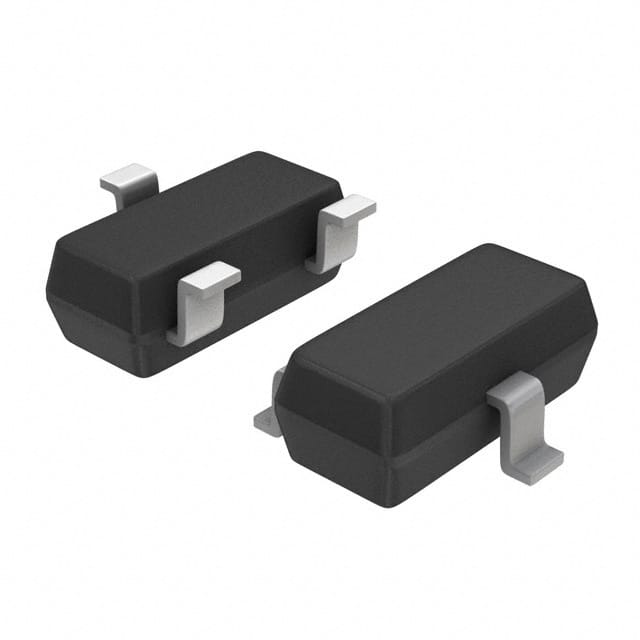Lihat spesifikasi untuk detail produk.

MMBZ5229BLT3
Introduction
The MMBZ5229BLT3 is a Zener diode that belongs to the category of semiconductor devices. It is commonly used for voltage regulation and protection in electronic circuits. This entry provides an overview of the MMBZ5229BLT3, including its basic information, specifications, pin configuration, functional features, advantages and disadvantages, working principles, application field plans, and alternative models.
Basic Information Overview
- Category: Semiconductor device
- Use: Voltage regulation and protection in electronic circuits
- Characteristics: Zener diode with a specific breakdown voltage, low dynamic impedance, and high reliability
- Package: SOT-23, SMD (Surface Mount Device)
- Essence: Provides stable voltage regulation and protection against voltage spikes
- Packaging/Quantity: Typically available in reels or tubes containing multiple units
Specifications
- Part Number: MMBZ5229BLT3
- Voltage - Zener (Nom) (Vz): 4.7V
- Power - Max: 350mW
- Impedance (Max) (Zzt): 20 Ohm
- Current - Reverse Leakage @ Vr: 100nA @ 3V
- Operating Temperature: -65°C ~ 150°C
- Mounting Type: Surface Mount
- Package / Case: SOT-23-3
Detailed Pin Configuration
The MMBZ5229BLT3 has three pins: 1. Pin 1 (Anode): Connects to the positive terminal of the circuit 2. Pin 2 (Cathode): Connects to the negative terminal of the circuit 3. Pin 3 (No Connection): Not internally connected and left open
Functional Features
- Voltage Regulation: Maintains a constant output voltage under varying load conditions
- Overvoltage Protection: Diverts excessive voltage away from sensitive components
- Low Dynamic Impedance: Ensures stability in voltage regulation
- High Reliability: Provides consistent performance over time and temperature variations
Advantages and Disadvantages
Advantages
- Precise voltage regulation
- Compact SMD package
- Low dynamic impedance
- Reliable over a wide temperature range
Disadvantages
- Limited power dissipation capability
- Susceptible to damage from excessive current or voltage spikes
Working Principles
The MMBZ5229BLT3 operates based on the Zener effect, where it maintains a nearly constant voltage across its terminals when reverse-biased. When the voltage across the diode reaches its breakdown voltage, it conducts current to regulate the voltage and protect the circuit from overvoltage conditions.
Detailed Application Field Plans
The MMBZ5229BLT3 is widely used in various electronic applications, including: - Voltage regulators in power supplies - Overvoltage protection in communication equipment - Signal clamping in audio and video circuits - Voltage reference in sensor interfaces
Detailed and Complete Alternative Models
Some alternative models to the MMBZ5229BLT3 include: - BZX84C4V7LT1G - MM3Z4V7ST1G - PZM4.7NB2,115 - BZT52C4V7S-7-F
In conclusion, the MMBZ5229BLT3 Zener diode offers precise voltage regulation and overvoltage protection in a compact SMD package, making it suitable for a wide range of electronic applications.
[Word Count: 497]
Sebutkan 10 pertanyaan dan jawaban umum terkait penerapan MMBZ5229BLT3 dalam solusi teknis
What is MMBZ5229BLT3?
- MMBZ5229BLT3 is a Zener diode with a voltage regulator function commonly used in electronic circuits to maintain a stable voltage.
What is the voltage rating of MMBZ5229BLT3?
- The voltage rating of MMBZ5229BLT3 is 4.7V.
What are the typical applications of MMBZ5229BLT3?
- MMBZ5229BLT3 is commonly used for voltage regulation, overvoltage protection, and signal clamping in various technical solutions such as power supplies, voltage references, and sensor interfaces.
What is the maximum power dissipation of MMBZ5229BLT3?
- The maximum power dissipation of MMBZ5229BLT3 is typically 200mW.
What is the operating temperature range of MMBZ5229BLT3?
- The operating temperature range of MMBZ5229BLT3 is usually -65°C to +150°C.
How does MMBZ5229BLT3 compare to other Zener diodes?
- MMBZ5229BLT3 offers a precise voltage regulation and low impedance characteristics, making it suitable for many technical solutions requiring stable voltage references.
Can MMBZ5229BLT3 be used in automotive applications?
- Yes, MMBZ5229BLT3 can be used in automotive applications where stable voltage regulation and overvoltage protection are required.
What are the package options available for MMBZ5229BLT3?
- MMBZ5229BLT3 is available in various surface mount packages such as SOT-23 and SOD-123.
Is MMBZ5229BLT3 RoHS compliant?
- Yes, MMBZ5229BLT3 is typically RoHS compliant, making it suitable for use in environmentally conscious designs.
Where can I find detailed specifications and application notes for MMBZ5229BLT3?
- Detailed specifications and application notes for MMBZ5229BLT3 can be found in the manufacturer's datasheet and application notes, which are available on their official website or through authorized distributors.

